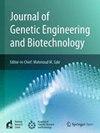池塘沉积物、对虾(Penaeus monodon)组织和池塘水中微生物分布的宏基因组研究:特别关注营养循环和对虾病毒病原体
IF 2.8
Q3 Biochemistry, Genetics and Molecular Biology
Journal of Genetic Engineering and Biotechnology
Pub Date : 2025-09-09
DOI:10.1016/j.jgeb.2025.100568
引用次数: 0
摘要
由于疾病爆发,东亚养殖的主要对虾品种单对虾在水产养殖方面面临挫折。宏基因组研究提供了对池塘微生物组的深入了解,揭示了其在营养循环、水质和疾病控制中的关键作用。本研究调查了印度西孟加拉邦Chaital一个水产养殖池塘沉积物、水和虾样品中的微生物群落。霰弹枪宏基因组测序和生物信息学分析用于评估分类和功能概况,重点关注营养循环基因和病毒种群。沉积物微生物多样性最高,有利于有机质分解和生态稳定。水微生物在氧化和抑制病原体中发挥作用,而虾组织中宿主的微生物有助于消化和免疫。致病性病毒,尤其是白斑综合征病毒(Whispovirus),在虾的组织中占主导地位。功能基因分析确定了碳、氮和硫循环的关键途径。将水质数据与微生物组资料相结合可以帮助识别生物指标并预测病原体风险。本文章由计算机程序翻译,如有差异,请以英文原文为准。
A metagenomic exploration of microbial distribution among the pond sediment, shrimp (Penaeus monodon) tissue and pond water: A special focus on nutrient cycling and shrimp viral pathogens
Penaeus monodon, a major shrimp species cultivated in Eastern Asia, has faced setbacks in aquaculture due to disease outbreaks. Metagenomic studies offer insights into the pond microbiome, revealing its critical roles in nutrient cycling, water quality, and disease control. This study investigated microbial communities in sediment, water, and shrimp samples from an aquaculture pond in Chaital, West Bengal, India. Shotgun metagenomic sequencing and bioinformatics analyses were used to assess taxonomic and functional profiles, focusing on nutrient cycling genes and viral populations. Sediments showed the highest microbial diversity, contributing to organic matter decomposition and ecological stability. Water microbes played roles in oxygenation and pathogen suppression, while shrimp tissues hosted microbes aiding digestion and immunity. Pathogenic viruses, especially Whispovirus (White Spot Syndrome Virus), dominated shrimp tissues. Functional gene analysis identified key pathways in carbon, nitrogen, and sulfur cycling. Integrating water quality data with microbiome profiles could help identify bioindicators and predict pathogen risks.
求助全文
通过发布文献求助,成功后即可免费获取论文全文。
去求助
来源期刊

Journal of Genetic Engineering and Biotechnology
Biochemistry, Genetics and Molecular Biology-Biotechnology
CiteScore
5.70
自引率
5.70%
发文量
159
审稿时长
16 weeks
期刊介绍:
Journal of genetic engineering and biotechnology is devoted to rapid publication of full-length research papers that leads to significant contribution in advancing knowledge in genetic engineering and biotechnology and provide novel perspectives in this research area. JGEB includes all major themes related to genetic engineering and recombinant DNA. The area of interest of JGEB includes but not restricted to: •Plant genetics •Animal genetics •Bacterial enzymes •Agricultural Biotechnology, •Biochemistry, •Biophysics, •Bioinformatics, •Environmental Biotechnology, •Industrial Biotechnology, •Microbial biotechnology, •Medical Biotechnology, •Bioenergy, Biosafety, •Biosecurity, •Bioethics, •GMOS, •Genomic, •Proteomic JGEB accepts
 求助内容:
求助内容: 应助结果提醒方式:
应助结果提醒方式:


